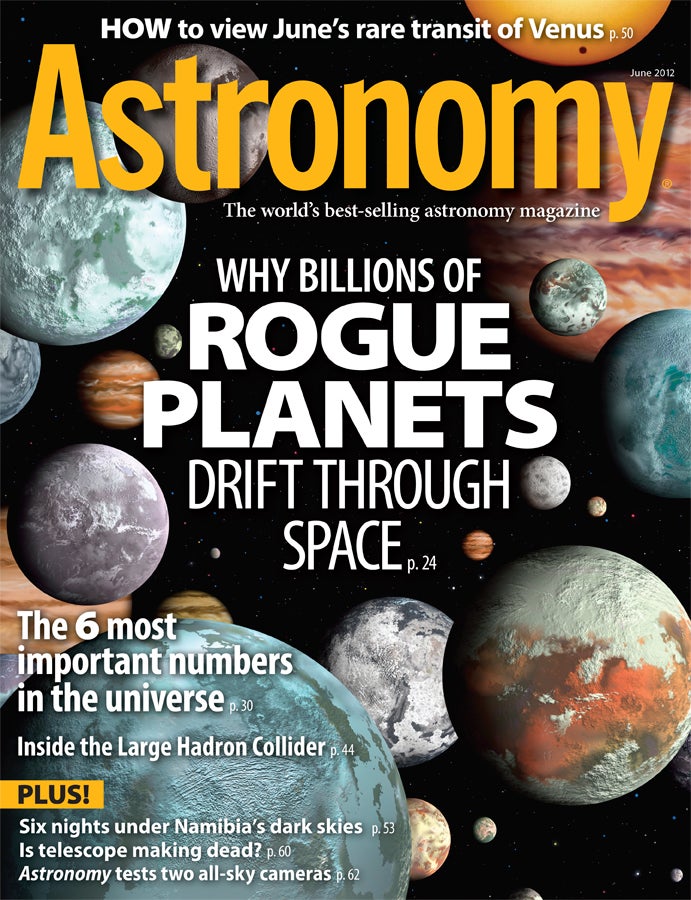
Waukesha, Wis. — Astronomers have tallied more than 760 planets around stars other than the Sun. But how many worlds might be untethered to parent stars? Author Steve Nadis addresses this question in “Do billions of rogue planets drift through space?”
Astronomers think so many unbound worlds likely exist because they “seem to be an inevitable consequence of the chaotic gravitational interactions prevalent in nascent planetary systems,” writes Nadis. In the article, he explains how two teams discovered untethered planets in 2011 using a technique called gravitational microlensing, which requires that “an object such as a previously unknown planet must align between a star and Earth.” Whit this method, scientists then can learn about the foreground object.
How many of these unknown worlds have scientists discovered so far? Why do they think many more exist? And what does this mean for planet formation theory? Read about the rogue-planet population in the June 2012 issue of Astronomy magazine, on newsstands May 1.
“Inside the world’s most powerful machine”
Scientists probe extremely high energies with powerful machines in order to learn about the universe and the laws of physics. For more than two years, the Large Hadron Collider (LHC) at the European Organization for Nuclear Research on the France-Switzerland border has been the major player in this type of research. The LHC is a nearly 16.6-mile-long (26.7 kilometers) loop that revs up particles to almost the speed of light and then collides them at the centers of huge detectors. Associate Editor Liz Kruesi takes you on a tour of these massive detectors and the products created during those high-speed collisions in “Inside the world’s most powerful machine.”
“How to view June’s rare Venus transit”
On the evening of June 5/6, the vast majority of the world’s population will witness a rare spectacle: Our sister planet will cross the Sun’s face. Venus previously transited the Sun in June 2004, but it won’t do so again until December 2117. In “How to view June’s rare Venus transit,” Senior Editor Richard Talcott provides tips on what to do the day of this event to ensure the best view. The transit will be visible from more than half of Earth’s surface, so make plans now.
“Six nights under Namibia’s dark skies”
A trio of Israeli astrophotographers traveled to the edge of the Kalahari Desert in Africa to image celestial showpieces in the southern sky. Tal Faibish, Kfir Simon, and author Harel Boren spent nearly a week at Namibia’s Tivoli Southern Sky Guest Farm to capture Omega Centauri, the Eta Carinae Nebula, the Milky Way’s core, and other spectacular sites. Boren shows off some of the group’s magnificent images and takes you along on the adventure in “Six nights under Namibia’s dark skies.”
June night-sky events visible without optical aid
- June 5/6 — Venus crosses the Sun’s face for the second and final time this century.
- June 17 —The Moon passes 1.1° north of Jupiter.
- June 17 — The Moon passes 2° north of Venus.
- June 27 — The Boötid meteor shower peaks with potentially dozens of meteors per hour.
Also in the June 2012 Astronomy
- “The 6 most important numbers in the universe” — Find out how the speed of light, the gravitational constant, and other big numbers govern the cosmos.
- “Is telescope making dead?” — Following World War II, most telescopes were homemade. Where are the amateur telescope makers today?
- “Astronomy tests two all-sky cameras” — Moonglow Technologies’ All Sky Cam and Orion’s StarShoot AllSky Camera will let you monitor the sky from horizon to horizon.
- “The Sky this Month” — Exclusive star charts will guide you through the night sky.
- The June issue of Astronomy also includes Astro News, Bob Berman’s Strange Universe, Glenn Chaple’s Observing Basics, Stephen James O’Meara’s Secret Sky, Tony Hallas’ Imaging the Cosmos, Beautiful Universe, Ask Astro, Letters, Web Talk, Deep-sky Showcase, New Products, Reader Gallery, and The Cosmic Grid.









